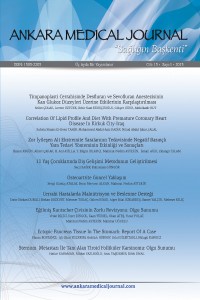Öz
Objective: It is known that, one of the most reliable methods in age estimation in the skeleton findings of non-adult individuals is the analysis of tooth development stages (odontogenesis). The aim of this study is to make a research on tooth development stages of eleven years old children, to compose our nation standards and to compare the results of this research with other researches. Methods: Panoramic radiographies of eighty one individuals at the age of eleven (44 males-37 females) were analyzed. Tooth development for eleven years old individuals were pictured from median values of data gathered according to the scheme prepared by adapting from Moorress (1963). Results: In the research, development of some teeth in eleven age group such as M-M and P differed from other studies’ results.Conclusion: Every society should developed its own standards because of the morphological differences among societies. Findings in this study have differences concerning our society as well. Using our standards in disciplines as Forensic Medicine, Forensic Odontology and Forensic Anthropology will give more reliable results.
Anahtar Kelimeler
Age estimation identification dental development forensic odontology
Kaynakça
- 1- Ubelaker, D. H, Human Skeletal Remains. Washington: Taraxacum, 1978; 63-69. 2- Bass, W.M., Human Osteology A Laboratory and Field Manual (4th Edition), Special Publication No : 2 of the Missouri Archaeological Society, Columbia: 1995. 3- Workshop of European Antropologists (WEA), “Recommendations for Age and Sex Diagnoses of Skeletons”, Journal of Human Evolution, 1980; 9 (7): 5175 4- Fazekas I. and Kosa K. Forensic fetal osteology. 1st Budapest Hungary Akademiai Kiado Publishers. 1978; 232-2 5- Stloukal M., Hanáková H. 1978. Die Länge der Längsknochen Altslawischer Bevölkerungen Unterbesonderer Berückichtigung von Wachstumsfragen. Homo, 29: 53-69. 6- Burns, K.R, Forensic Anthropology Training Manual. University of North Carolina at Charlotte, Illustrations by Joanna Wallington, 1999; 126-127. 7- Beach, J. J, Christopher W. S, Sharkey, R. A, Dental Aging Techniques: A Review Age Estimation of the Human Skeleton. Edited by Krista E. L, Finnegan, M, Charles C. Thomas, Publisher, Springfield, Illinois, U.S.A., 2010;5-18. 8- Meinl, M.A, The Application of Dental Age Estimation Methods: Comparative Validity and Problems in Practical Implementation. Doctoral Thesis, Department of Anthropology University of Vienna, 2007; 1-122. 9- Miles, a. E. W, Dentition in the Estimation of Age. Journal of Dental Research, 1963; 42:255: 255-263. 10- Schour, I, Massler, M, The development of the human dentition. Journal of the American Dental Association, 1941; 28:1153-1160. 11- Solak, A, Dental Maturity As an Indicatör of Chronological Age: Validity of the Demirjian Method for Dental Ag Estimation When Applied to Turkish Children. Doctorate Thesis, Orthodontic Department, University of Marmara, 2006; 1-137. 12- Moorrees, C. F. A, Fanning, E. A, Hunt, E.E, Age variation of formation stages for ten permanent teeth. Journal of Dental Research, 1963, 42:1490-1502. 13- Demirjian A, Goldstein H, Tanner J. M, A new system of dental age assessment. Human Biology, 1973; 45:2112 14- White, T. D, Folkens, P.A, The Human Bone Manual. Elsevier Academic Press, 2005; 136-137.
Öz
Özet:
Amaç:
Yetişkin olmayan bireylerin iskelet kalıntılarında, yaş tahminindeki en güvenilir yöntemlerden birinin diş gelişim aşamaları olduğu bilinmektedir. Bu çalışmanın amacı; on bir yaşındaki canlı bireylerden elde edilecek verilerle ülkemize özgü standartlarının oluşturulması ve bu yöntemin diğer diş gelişim metotlarıyla karşılaştırılmasıdır.
Gereç ve Yöntem:
Çalışma kapsamında; Ankara’da yaşamakta olan on bir yaşındaki seksen bir bireyin (44 erkek – 37 kız) panoramik radyografileri incelenmiş ve diş gelişimleri değerlendirilerek elde edilen medyan değerleri vasıtasıyla, Moorress (1963)’ten uyarlanarak hazırlanan şemaya göre on bir yaş için diş gelişimi resmedilmiştir.
Bulgular:
Araştırmada on bir yaş grubundaki bazı dişlerin gelişimi; M2-M2 ve P2 gibi, diğer çalışmalardakilerden farklılık göstermiştir.
Sonuç:
Çeşitli toplumların kendilerine göre geliştirmiş oldukları diş atlaslarını kullanarak yapılan yaş tahminleri; toplumlar arasında gözlemlenebilecek morfolojik farklılıklardan dolayı bazı hataların oluşmasına sebep olacağından, her toplum kendine özgü standartları oluşturmalıdır. Bu çalışmada elde edilen bulgular da bizim toplumumuza özgü farklılıkları yansıtmaktadır. Adli Odontoloji, Adli Tıp ve Adli Antropoloji gibi alanlarda kendi standartlarımızın kullanılması daha güvenilir sonuçlar verecektir.
Anahtar Kelimeler
Kaynakça
- 1- Ubelaker, D. H, Human Skeletal Remains. Washington: Taraxacum, 1978; 63-69. 2- Bass, W.M., Human Osteology A Laboratory and Field Manual (4th Edition), Special Publication No : 2 of the Missouri Archaeological Society, Columbia: 1995. 3- Workshop of European Antropologists (WEA), “Recommendations for Age and Sex Diagnoses of Skeletons”, Journal of Human Evolution, 1980; 9 (7): 5175 4- Fazekas I. and Kosa K. Forensic fetal osteology. 1st Budapest Hungary Akademiai Kiado Publishers. 1978; 232-2 5- Stloukal M., Hanáková H. 1978. Die Länge der Längsknochen Altslawischer Bevölkerungen Unterbesonderer Berückichtigung von Wachstumsfragen. Homo, 29: 53-69. 6- Burns, K.R, Forensic Anthropology Training Manual. University of North Carolina at Charlotte, Illustrations by Joanna Wallington, 1999; 126-127. 7- Beach, J. J, Christopher W. S, Sharkey, R. A, Dental Aging Techniques: A Review Age Estimation of the Human Skeleton. Edited by Krista E. L, Finnegan, M, Charles C. Thomas, Publisher, Springfield, Illinois, U.S.A., 2010;5-18. 8- Meinl, M.A, The Application of Dental Age Estimation Methods: Comparative Validity and Problems in Practical Implementation. Doctoral Thesis, Department of Anthropology University of Vienna, 2007; 1-122. 9- Miles, a. E. W, Dentition in the Estimation of Age. Journal of Dental Research, 1963; 42:255: 255-263. 10- Schour, I, Massler, M, The development of the human dentition. Journal of the American Dental Association, 1941; 28:1153-1160. 11- Solak, A, Dental Maturity As an Indicatör of Chronological Age: Validity of the Demirjian Method for Dental Ag Estimation When Applied to Turkish Children. Doctorate Thesis, Orthodontic Department, University of Marmara, 2006; 1-137. 12- Moorrees, C. F. A, Fanning, E. A, Hunt, E.E, Age variation of formation stages for ten permanent teeth. Journal of Dental Research, 1963, 42:1490-1502. 13- Demirjian A, Goldstein H, Tanner J. M, A new system of dental age assessment. Human Biology, 1973; 45:2112 14- White, T. D, Folkens, P.A, The Human Bone Manual. Elsevier Academic Press, 2005; 136-137.
Ayrıntılar
| Birincil Dil | Türkçe |
|---|---|
| Bölüm | Araştırmalar |
| Yazarlar | |
| Yayımlanma Tarihi | 1 Ocak 2013 |
| Yayımlandığı Sayı | Yıl 2013 Cilt: 13 Sayı: 1 |


